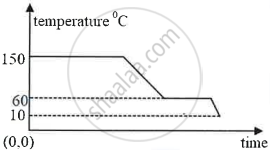Advertisements
Advertisements
प्रश्न
Name two factors on which the heat absorbed or given out by a body depends.
उत्तर
The mass and specific heat capacity are two factors on which the heat absorbed or given out by a body depends.
APPEARS IN
संबंधित प्रश्न
State two characteristics of a good thermion emitter.
State any two measures to minimize the impact of global warming.
1 g ice of 0℃ melts to form 1 g water at 0℃. State whether the latent heat is absorbed or given out by ice.
Which has more heat: 1 g ice at 0℃ or 1g water 0℃? Give reason.
Explain the following:
The surrounding become pleasantly warm when water in a lake starts freezing in cold countries.
Explain the following:
The heat supplied to a substance during it change of state, does not cause any rise in its temperature.
A refrigerator converts 100g of water at 20℃ to ice at – 10℃ in 73.5 min. Calculate the average rate of heat extraction in watt. The specific heat capacity of water is 4.2 J kg-1 K-1, specific latent heat of ice is 336 J g-1 and the specific heat capacity of ice is 2.1 J kg-1 K-1.
What is the name given to the energy absorbed during a phase change?
Explain the meaning of the term latent heat. State its S. I. unit.
Define the term ‘specific latent heat of fusion’ of a substance.
Explain, why no tracks are left on the ice during ice skating?
Steam at 100°C is passed over 1000 g of ice at 0°C. After some time, 600 g of ice at 0°C is left and 450 g of water at 0°C is formed. Calculate the specific latent heat of vaporization of steam (Given: specific heat capacity of water = 4200 J/kg°C, specific latent heat of fusion of ice = 336,000 J/kg.)
Define boiling point of a liquid.
Match the columns.
| Column A | Column B |
| 1) Specific latent heat of fusion | a) Air saturated with vapour |
| 2) Specific latent heat of vaporisation | b) Solid converts into liquid |
| 3) Dew point temperature | c) liquid converts into gas |
Write scientific reason.
Even if boiling water is constantly heated, its temperature does not rise.
Specific latent heat of a substance ______.
Calculate the total amount of heat energy required to melt 200 g of ice at 0°C to water at 100°C. (Specific latent heat of ice = 336 Jg-1, specific heat capacity of water = 4.2 Jg-1 °C-1)
The diagram below shows a cooling curve for a substance:

- State the temperatures at which the substance condenses.
- The temperature range in which the substance is in liquid state.
- Why do we prefer ice to ice-cold water for cooling a drink?
20 g of ice at 0°C absorbs 10,920 J of heat energy to melt and change to water at 50°C. Calculate the specific latent heat of fusion of ice. Specific heat capacity of water is 4200 J kg-1 K-1.
